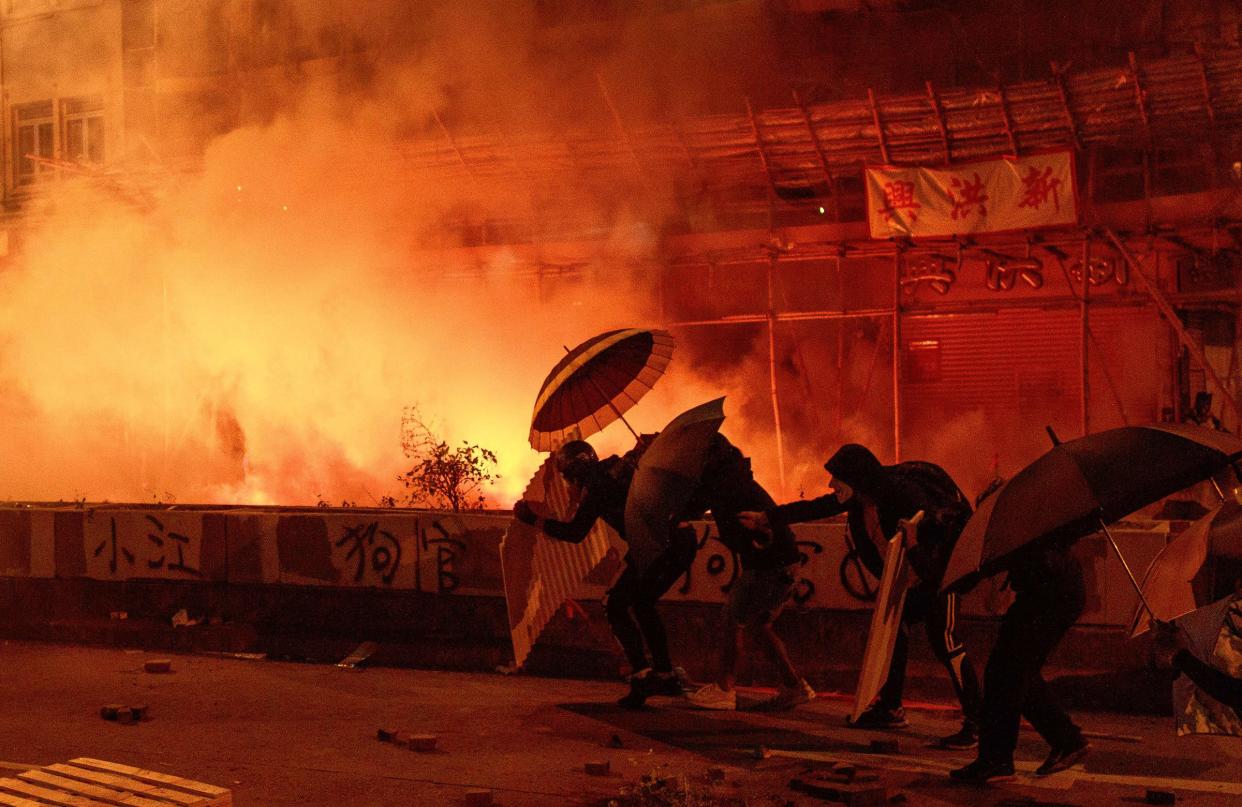A Siege in Hong Kong Heralds a New Phase of Protest

For almost six months, the unrest in Hong Kong has followed a rhythm. On weekends, the Chinese-ruled enclave would convulse with pro-democracy protests. During the workweek, the acrid haze of tear gas would clear and life moved on, though the revolutionary graffiti haranguing the Communist Party of China lingered.
But in November, the struggle took a sudden and dangerous new turn. After a student demonstrator died on Nov. 8 of complications from a fall during a protest, the weekly schedule surrendered to daily urban warfare. The demonstrators say normality cannot be restored. “We can’t just protest on the weekends anymore,” says Ezoe, a 20-year-old medical student. “If we are going to win this fight, people need to stop their jobs. The government needs to see the economy will hurt.”
The latest escalation eventually centered on the city’s universities, where students like Ezoe holed up to resist arrest. That places of learning have become battlegrounds strikes at the symbolic heart of the freedoms and values that Hong Kongers believe distinguish their semiautonomous city from the rest of China. While Beijing has tried for years to push patriotic education here and state media have suggested that changes to the curriculum might solve the crisis, faculty, students and staff have resisted attempts to infringe on their academic independence.
With on-campus lectures canceled, students’ energies went into stockpiling medieval–style weaponry like fencing blades, slingshots and bows and arrows and fortifying blockades in preparation for showdowns with police. After some of the bloodiest confrontations since the unrest began, demonstrators filtered into one last holdout: Polytechnic University.
Protesters bunkered inside the campus for a week, using it as a base to disrupt traffic and block the adjoining Cross Harbour Tunnel, a vital artery linking the city’s most populous region to the commercial and financial districts on Hong Kong Island. Police encircled the area, and a days-long siege began in earnest on Nov. 17. Students returned a hailstorm of rubber bullets and tear-gas volleys with gasoline bombs, fiery arrows and barricades set ablaze. Some managed to evade the police in daring escapes, including rappelling down makeshift ropes to waiting motorcycles, but many more were detained. By Nov. 19, police said they had arrested or taken down the details of 1,100 people in and around “PolyU.” As TIME went to press, dozens remained inside, refusing to surrender.
Although the size of the demonstrations has dwindled in recent weeks, it is no longer only student provocateurs squaring off with police. Amid a growing sense that peaceful protest is futile, the city’s financial district is now regularly shrouded with tear gas in the middle of the workday. At lunchtime, bankers have joined street brawls, facing off with police against the backdrop of Chanel and Louis Vuitton stores. Amid a general strike, transportation has snarled and public schools were forced into a six-day shutdown. “This is no longer just a protest movement,” says Yu, a 21-year-old student. “We are at war for Hong Kong’s future.”
Yet as the frontline protesters have grown more -radical—committing arson, vandalizing subway stations and even dousing one detractor in flammable liquid and setting him on fire—they continue to retain public support. A survey by the Hong Kong Public Opinion Research Institute published on Nov. 15 found 83% of people faulted the government for the spiraling violence, while fewer than half blamed the demonstrators. “Whatever they do, I will support the protesters,” says Tim, 30, a hotel worker who says he stopped joining the protests after they became more violent. “If we don’t support them we will have a worse future with no more rights.”
While the students at PolyU camped out, -ordinary Hong Kongers came to their aid. Some traveled hours to bring supplies, while a group of teary-eyed relatives and friends staged a sit-in in front of police, who refused them access to the university. Other demonstrators staged a “blossom everywhere” campaign to draw police away from the institution.
This protracted unrest has taken a toll on workers like Tim. As tourists stay away, almost 8 in 10 hotel staffers have been asked to take a few days’ unpaid leave, according to a union poll. Hong Kong has fallen into recession as its upscale hotels and glitzy shopping malls become backdrops to bloody duels. Many outside Hong Kong now fear what will befall Asia’s world city. On Nov. 19, the U.S. Senate unanimously passed the Hong Kong Human Rights and Democracy Act, which aims to safeguard the territory’s autonomy from any incursions by Beijing. But China sees the bill as an infringement on its sovereignty and already blames the current crisis on meddling foreign forces.
For all the protections and declarations of support the world may try to offer, many Hong Kongers say they cannot afford to lose this fight because the -alternative would mean an end to the city’s unique set of freedoms. And so for all the disruptions, chaos and danger, they would still rather live by the fits and starts of the protests than the dictates of Beijing. “I am much more afraid,” says Bryan, a 30-year-old protester, “of what will happen if we don’t stand up.”

